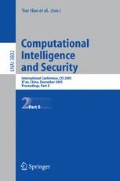Abstract
In this paper, we presents HyperSausage Neuron based on the High-Dimension Space(HDS), and proposes a new algorithm for speaker independent continuous digit speech recognition. At last, compared to HMM-based method, the recognition rate of HyperSausage Neuron method is higher than that of in HMM-based method.
Access this chapter
Tax calculation will be finalised at checkout
Purchases are for personal use only
Preview
Unable to display preview. Download preview PDF.
References
Yang, W.-J.: Hidden Markov Model for Mandarin lexical tone recognition. IEEE Trans. Acoust. Speech Signal Process 36, 988–992 (1988)
Shou-jue, W.: Biomimetic (Topological) Pattern Recognition —— A New Model of Pattern Recognition Theory and Its Applications (in Chinese). Acta Electronica Sinica 30(10), 1417–1420 (2002)
Wang, S.J., Zhao, X.T.: Biomimetic pattern recognition theory and its applications. Chinese Journal of Electronics 13(3), 373–377 (2004)
Cao, W., Hao, F., Wang, S.: The application of DBF neural networks for object recognition. Information Science 160(1-4), 153–160 (2004)
Wenming, C.: The application of Direction basis function neural networks to the prediction of chaotic time series. Chinese Journal of Electronics 13(3), 395–398 (2004)
Cao, W.M., Feng, H., Zhang, D.M., et al.: An adaptive controller for a class of nonlinear system using direction basis function. Chinese journal of electronics 11(3), 303–306 (2002)
Shoujue, W.: A new development on ANN in China - Biomimetic pattern recognition and multi weight vector neurons. In: Wang, G., Liu, Q., Yao, Y., Skowron, A. (eds.) RSFDGrC 2003. LNCS (LNAI), vol. 2639, pp. 35–43. Springer, Heidelberg (2003)
Cao, W., Hu, J., Xiao, G., Wang, S.: Application of multi-weighted neuron for iris recognition. In: Wang, J., Liao, X.-F., Yi, Z. (eds.) ISNN 2005. LNCS, vol. 3497, pp. 87–92. Springer, Heidelberg (2005)
Cao, W., Pan, X., Wang, S.: Continuous speech research based on two-weight neural network. In: Wang, J., Liao, X.-F., Yi, Z. (eds.) ISNN 2005. LNCS, vol. 3497, pp. 345–350. Springer, Heidelberg (2005)
Wang, S.J., Chen, Y.M., Wang, X.D., et al.: Modeling and optimization of semiconductor manufacturing process with neural networks. Chinese Journal of Electronics 9(1), 1–5 (2000)
Author information
Authors and Affiliations
Editor information
Editors and Affiliations
Rights and permissions
Copyright information
© 2005 Springer-Verlag Berlin Heidelberg
About this paper
Cite this paper
Cao, W., Li, J., Wang, S. (2005). Continuous Speech Research Based on HyperSausage Neuron. In: Hao, Y., et al. Computational Intelligence and Security. CIS 2005. Lecture Notes in Computer Science(), vol 3802. Springer, Berlin, Heidelberg. https://doi.org/10.1007/11596981_166
Download citation
DOI: https://doi.org/10.1007/11596981_166
Publisher Name: Springer, Berlin, Heidelberg
Print ISBN: 978-3-540-30819-5
Online ISBN: 978-3-540-31598-8
eBook Packages: Computer ScienceComputer Science (R0)

